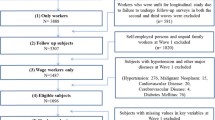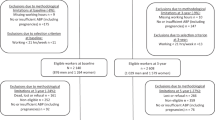Abstract
This cohort study aimed to investigate the association between household income and incident hypertension in a Japanese employed population. During 2012, a total of 4314 normotensive daytime employees (3153 men and 1161 women) were included in this study. Participants had a wide range of occupations and were employed at one of 12 workplaces from various economic sectors in Japan. After a 2-year follow-up, incident hypertension was compared among groups according to household income: <5.0, 5.0–7.9, 8.0–9.9, and ≥10.0 million Japanese yen (¥)/year. A Cox proportional hazard model was used to calculate the hazard ratio for incident hypertension in each household income group, compared with the group earning <5.0 million ¥/year. The hazard ratios for men were 1.52 (95% confidence interval, 1.08–2.18) for 5.0–7.9 million ¥/year, 1.49 (0.98–2.27) for 8.0–9.9 million ¥/year, and 1.92 (1.23–3.01) for ≥10.0 million ¥/year after adjusting for age, baseline systolic blood pressure, worksite, type of occupation, number of family members, and smoking status. This positive relationship was attenuated but remained significant after further adjustment for alcohol consumption and body mass index, both of which were higher among men with higher household income. Conversely, there was no significant difference for women in the risk of incident hypertension among household income groups, although those with higher household income tended to have a lower risk of incident hypertension. Household income is positively associated with the onset of hypertension in Japanese employed men working daytime hours.

Similar content being viewed by others
References
Singh GM, Danaei G, Farzadfar F, Stevens GA, Woodward M, Wormser D, et al. The age-specific quantitative effects of metabolic risk factors on cardiovascular diseases and diabetes: a pooled analysis. PLoS One. 2013;8:e65174.
Global Burden of Metabolic Risk Factors for Chronic Diseases Collaboration. Cardiovascular disease, chronic kidney disease, and diabetes mortality burden of cardiometabolic risk factors from 1980 to 2010: a comparative risk assessment. Lancet Diabetes Endocrinol. 2014;2:634–47.
Ikeda N, Inoue M, Iso H, Ikeda S, Satoh T, Noda M, et al. Adult mortality attributable to preventable risk factors for non-communicable diseases and injuries in Japan: a comparative risk assessment. PLoS Med. 2012;9:e1001160.
Yang MH, Kang SY, Lee JA, Kim YS, Sung EJ, Lee KY, et al. The effect of lifestyle changes on blood pressure control among hypertensive patients. Korean J Fam Med. 2017;38:173–80.
Hashimoto T, Takase H, Okado T, Sugiura T, Yamashita S, Kimura G, et al. Significance of adjusting salt intake by body weight in the evaluation of dietary salt and blood pressure. J Am Soc Hypertens. 2016;10:647–55.
Leng B, Jin Y, Li G, Chen L, Jin N. Socioeconomic status and hypertension: a meta-analysis. J Hypertens. 2015;33:221–9.
Hajat A, Kaufman JS, Rose KM, Siddiqi A, Thomas JC. Do the wealthy have a health advantage? Cardiovascular disease risk factors and wealth. Soc Sci Med. 2010;71:1935–42.
Leigh JP, Du J. Are low wages risk factors for hypertension? Eur J Public Health. 2012;22:854–9.
Lemstra M, Rogers M, Moraros J. Income and heart disease: neglected risk factor. Can Fam Physician. 2015;61:698–704.
Nadrowski P, Podolecka E, Pajak A, Dorynska A, Drygas W, Bielecki W, et al. How does the risk of cardiovascular death and cardiovascular risk factor profiles differ between socioeconomic classes in Poland: a country in transition. Cardiol J. 2019;26:493–502.
Lucumi DI, Schulz AJ, Roux AVD, Grogan-Kaylor A. Income inequality and high blood pressure in Colombia: a multilevel analysis. Cad Saude Publica. 2017;33:e00172316.
Baek TH, Lee HY, Lim NK, Park HY. Gender differences in the association between socioeconomic status and hypertension incidence: the Korean Genome and Epidemiology Study (KoGES). BMC Public Health. 2015;15:852.
Sun Z, Zheng L, Detrano R, Zhang X, Xu C, Li J, et al. Incidence and predictors of hypertension among rural Chinese adults: Results from Liaoning province. Ann Fam Med. 2010;8:19–24.
Thawornchaisit P, de Looze F, Reid CM, Seubsman SA, Sleigh AC. Thai Cohort Study Team. Health risk factors and the incidence of hypertension: 4-year prospective findings from a national cohort of 60569 Thai Open University students. BMJ Open. 2013;3:e002826.
Oshio T, Inoue A, Tsutsumi A. Examining the mediating effect-of-work-to-family-conflict-on-the-associations-between-job-stressors-and-employee-psychological distress: a prospective cohort study. BMJ Open. 2017;7:e015608.
Oshio T, Tsutsumi A, Inoue A. Can leisure-time physical-activity-improve-health-checkup-results?-Evidence-from-Japanese-occupational-panel data. J Occup Health. 2016;58:354–64.
Umemura S, Arima H, Arima S, Asayama K, Dohi Y, Hirooka Y, et al. The Japanese society of hypertension guidelines for the management of hypertension (JSH 2019). Hypertens Res. 2019;42:1235–481.
Morikawa Y, Nakagawa H, Miura K, Ishizaki M, Tabata M, Nishijo M, et al. Relationship between shift work and onset of hypertension in a cohort of manual workers. Scand J Work Environ Health. 1999;25:100–4.
Haneda M, Noda M, Origasa H, Noto H, Yabe D, Fujita Y, et al. Japanese clinical practice guideline for diabetes 2016. Diabetol Int. 2018;9:1–45.
Kinoshita M, Yokote K, Arai H, Iida M, Ishigaki Y, Ishibashi S, et al. Japan atherosclerosis society (JAS) guidelines for prevention of atherosclerotic cardiovascular diseases 2017. J Atheroscler Thromb. 2018;25:846–984.
Robert SA, Booske BC. US opinions on health determinants and social policy as health policy. Am J Public Health. 2011;101:1655–63.
Wilkinson RG, Pickett KE. Income inequality and population health: a review and explanation of the evidence. Soc Sci Med. 2006;62:1768–84.
Kawachi I, Kennedy BP. Income inequality and health: pathways and mechanisms. Health Serv Res. 1999;34:215–27.
Wilkinson RG. Health inequalities: relative or10 absolute material standards?. BMJ. 1997;314:591–5.
Statistics Bureau of Japan. Family Income and Expenditure Survey. https://www.e-stat.go.jp/stat-search/files?page=1&layout=datalist&toukei=00200561&tstat=000000330001&cycle=7&year=20170&month=0&tclass1=000000330001&tclass2=000000330019&tclass3=000000330020&result_back=1. Accessed 7 Jan 2020.
Cabinet Office, Japan. The Public Opinion Survey on the Life of the People, 2016. https://survey.gov-online.go.jp/h28/h28-life/gairyaku.pdf. Accessed 7 Jan 2020.
Nakamura S, Inayama T, Hata K, Matsushita M, Takahashi M, Harada K, et al. Association of household income and education with eating behaviors in Japanese adults: a cross-sectional study. BMC Public Health. 2016;16:61.
Wildman RP, Gu D, Muntner P, Huang G, Chen J, Duan X, et al. Alcohol intake and hypertension subtypes in Chinese men. J Hypertens. 2005;23:737–43.
Shihab HM, Meoni LA, Chu AY, Wang NY, Ford DE, Liang KY, et al. Body mass index and risk of incident hypertension over the life course: the Johns Hopkins Precursors Study. Circulation. 2012;126:2983–9.
Iwasaki K, Takahashi M, Nakata A. Health problems due to long working hours in Japan: working hours, workers’ compensation (Karoshi), and preventive measures. Ind Health. 2006;44:537–40.
The Japan Institute for Labour Policy and Training. Databook of International Labour Statistics 2011. http://www.jil.go.jp/kokunai/statistics/databook/2011/documents/databook2011.pdf. Accessed 7 Jan 2020.
Nakamura K, Sakurai M, Morikawa Y, Miura K, Ishizaki M, Kido T, et al. Overtime work and blood pressure in normotensive Japanese male workers. Am J Hypertens. 2012;25:979–85.
Ministry of Health, Labour and Welfare of Japan. Labour Standards Act. https://elaws.e-gov.go.jp/search/elawsSearch/elaws_search/lsg0500/detail/lawId=322AC0000000049. Accessed 7 Jan 2020.
Ministry of Health, Labour and Welfare of Japan. Comprehensive Survey of Living Conditions 2012. Standards Act. https://www.mhlw.go.jp/toukei/saikin/hw/k-tyosa/k-tyosa12/dl/03.pdf. Accessed 7 Jan 2020.
Bureau of Taxation, Tokyo. Individual inhabitant tax https://www.tax.metro.tokyo.jp/kazei/kojin_ju.html. Accessed 7 Jan 2020.
Hoebel J, Kuntz B, Kroll LE, Schienkiewitz A, Finger LD, Lange C, et al. Socioeconomic inequalities in the rise of adult obesity: a time-trend analysis of national examination data from Germany, 1990–2011. Obes Facts. 2019;12:344–56.
Miyaki K, Song Y, Taneichi S, Tsutsumi A, Hashimoto H, Kawakami N, et al. Socioeconomic status is significantly associated with the dietary intakes of folate and depression scales in Japanese workers (J-HOPE Study). Nutrients. 2013;5:565–78.
Yamashita M, Tabara Y, Higo Y, Setoh K, Kawaguchi T, Takahashi Y, et al. Association between socioeconomic factors and urinary sodium-to-potassium ratio: the Nagahama Study. Hypertens Res. 2018;41:973–80.
Acknowledgements
The authors would like to thank all participants in J-HOPE.
Funding
We used panel data from an occupational cohort study on social class and health in Japan (J-HOPE), which was supported by a Grant-in-Aid for Scientific Research (KAKENHI) on Innovative Areas (Research in a Proposed Research Area) 2009–2013 (No. 4102-21119001) from the Ministry of Education, Culture, Sports, Science and Technology, Japan. The present study was financially supported by a Grant-in-Aid for Scientific Research (KAKENHI) from the Japan Society for the Promotion of Science (Grant No. 26253042).
Author information
Authors and Affiliations
Corresponding author
Ethics declarations
Conflict of interest
The authors declare that they have no conflict of interest.
Additional information
Publisher’s note Springer Nature remains neutral with regard to jurisdictional claims in published maps and institutional affiliations.
Rights and permissions
About this article
Cite this article
Yanagiya, S., Nakamura, K., Ukawa, S. et al. Household income and the risk of incident hypertension in employees at multiple workplaces in Japan: J-HOPE. Hypertens Res 43, 1445–1453 (2020). https://doi.org/10.1038/s41440-020-0517-y
Received:
Revised:
Accepted:
Published:
Issue Date:
DOI: https://doi.org/10.1038/s41440-020-0517-y
- Springer Nature Singapore Pte Ltd.




